We may not have the course you’re looking for. If you enquire or give us a call on +55 8000201623 and speak to our training experts, we may still be able to help with your training requirements.
Training Outcomes Within Your Budget!
We ensure quality, budget-alignment, and timely delivery by our expert instructors.
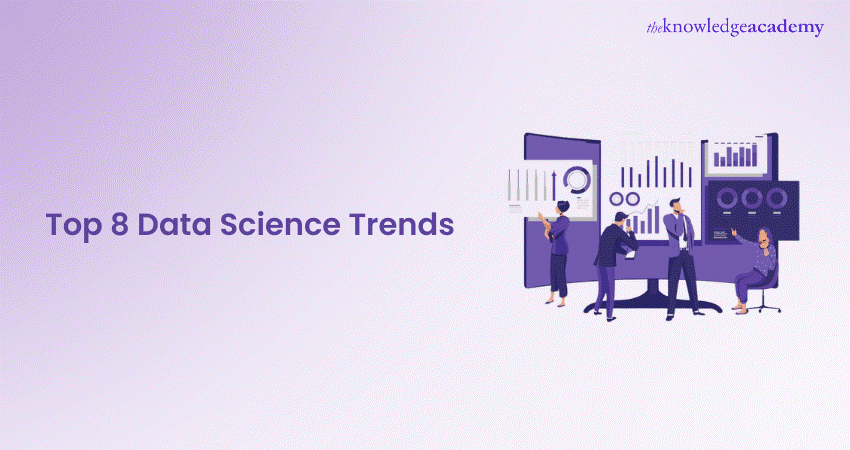
Our world is dominated by technology, and data plays a monumental role in it. Love it or hate it, one cannot live without it. Dealing with data can be a huge challenge for many organisations, and that’s where Data Science comes in. It plays a key role in the collection and transformation of data into actionable insights. Understanding the Top Data Science Trends can help you attain success and stay ahead of the competition.
In this blog, you will learn the Top 8 Data Science Trends that are driving the field forward. Let’s delve in deeper to learn more about it!
Table of Contents
1) The latest Data Science Trends
a) AI-powered Data Analytics
b) Edge computing in Data analysis
c) Responsible AI and ethics
d) AutoML and Augmented Analytics
e) Natural Language Processing (NLP)
f) Quantum computing in Data Science
g) Data privacy and security
h) Multi-modal Data Integration
2) Conclusion
The latest Data Science Trends
From Data Analytics powered by AI to Quantum Computing, the Data Science Trends include many. Let’s take a look at some of them here:
AI-powered Data Analytics
In the domain of Data Science, AI-powered Data Analytics stands out as a beacon of innovation. This transformative approach is revolutionising the way organisations harness data. It helps unlock detailed insights from huge and complex datasets. The influence of AI-powered Data Analytics on businesses is profound and has reshaped their operations. Let’s explore its impact on modern businesses:
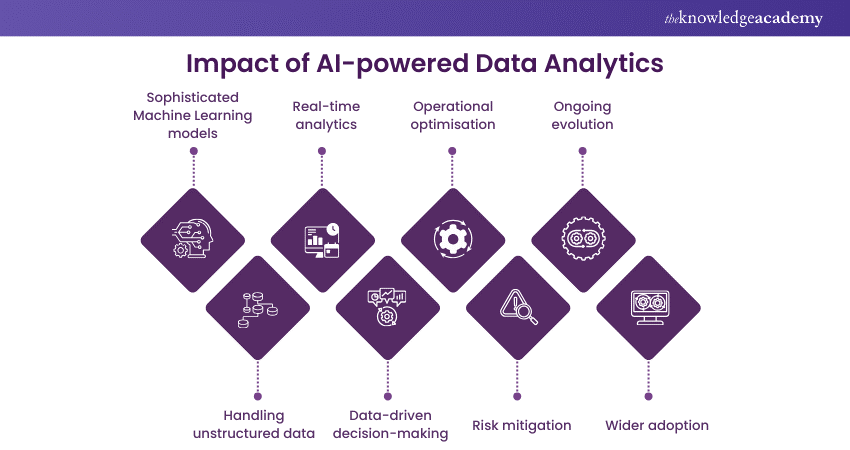
1) Sophisticated Machine Learning models: At the core of AI-powered Data Analytics lies the utilisation of advanced machine learning models. These models possess the remarkable ability to analyse data, recognise intricate patterns, and make accurate predictions.
2) Handling unstructured data: Traditional analytics often struggle with unstructured data elements such as text, images, and video. However, AI-driven analytics excel at processing these data types, expanding their Data Science Applications across a wide array of industries, including healthcare, finance, and marketing.
3) Real-time analytics: A pivotal advancement is the introduction of real-time Data Analytics powered by AI. This capability minimises latency, making real-time data analysis feasible and critical in applications like the Internet of Things (IoT).
4) Data-driven decision-making: AI empowers organisations to make swift, data-driven decisions with an unprecedented level of accuracy, enhancing strategic planning and execution.
5) Operational optimisation: Companies can optimise their operations, streamline processes, and enhance customer experiences, gaining a significant competitive edge through AI-driven insights.
6) Risk mitigation: AI's depth and speed of analysis are unparalleled. It uncovers hidden opportunities and mitigates risks that might otherwise remain undetected, fortifying an organisation's resilience.
7) Ongoing evolution: As AI technology continues to evolve and mature, AI-powered Data Analytics will become even more sophisticated. This will result in the delivery of increasingly accurate and valuable insights, enabling organisations to stay ahead in the data-driven landscape.
8) Wider adoption: The trend of AI-powered Data Analytics is expected to see wider adoption across various industries as organisations recognise its potential to drive innovation and competitive advantage.
AI-powered Data Analytics represents a seismic shift in the field of data analysis. Its capacity to seamlessly handle diverse data sources, provide real-time insights and enhance decision-making positions it as a driving force in the future of Data Science.
Elevate your Data Science expertise with our Data Science And Blockchain Training – Sign up now!
Edge computing in Data analysis
Edge computing involves processing data near the point of data generation rather than sending it to a centralised cloud server. Here is how it can benefit businesses:
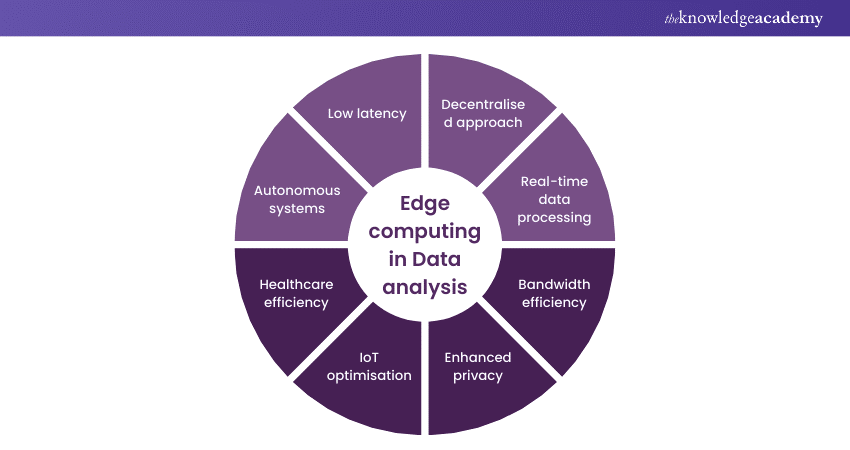
1) Low latency: Edge computing minimises latency, as data doesn't have to travel long distances for processing. This makes it ideal for applications where split-second decisions are critical.
2) Decentralised approach: It's a decentralised approach, distributing computing power to devices or "edge" locations, such as IoT devices, sensors, and mobile devices.
3) Real-time data processing: One of the most significant advantages is the ability to process data in real time. This is particularly beneficial in scenarios like autonomous vehicles, where instantaneous decisions are imperative for safety.
4) Bandwidth efficiency: Edge computing reduces the need to transmit large volumes of data to central servers, saving bandwidth and associated costs.
5) Enhanced privacy: Data remains closer to its source, improving data privacy and security, which is crucial for sensitive applications like healthcare.
6) IoT optimisation: IoT devices benefit from edge computing as it enables them to process data locally, reducing response times and conserving power.
7) Healthcare efficiency: In healthcare, edge computing enhances the efficiency of wearable health devices and medical equipment by providing real-time monitoring and diagnosis.
8) Autonomous systems: Edge computing is a game-changer for autonomous systems, including self-driving cars and drones, as it allows them to make critical decisions without relying on distant data centres.
Edge computing is expected to become even more deeply integrated into various industries, revolutionising the way data is processed and analysed. The fusion of AI and edge computing will further enhance the capabilities of real-time analytics, enabling more intelligent decision-making at the edge.
Edge computing in data analysis is one of the latest Trends in Data Science with far-reaching implications. It enables organisations to harness the power of data at the source, reducing latency, improving privacy, and making real-time analytics a reality. As technology continues to improve, the adoption of edge computing is likely to increase across industries, fueling innovation and efficiency
Responsible AI and ethics
Responsible AI refers to the development, deployment, and use of AI systems in ways that adhere to ethical principles, human rights, and societal values. It includes ethical considerations such as fairness, transparency, accountability, and the mitigation of biases in AI algorithms. The impact of Responsible AI and Ethics on businesses and society is profound. Let’s take a look at some of them here:
1) Human-centric approach: Responsible AI places humans at the centre of AI design and ensures AI benefits society as a whole rather than harming individuals or marginalised groups.
2) Bias mitigation: Responsible AI seeks to eliminate biases in AI systems that could lead to unfair or discriminatory outcomes, especially in areas like hiring, lending, and law enforcement.
3) Transparency: It emphasises transparency in AI algorithms and decision-making processes, enabling users to understand how AI systems arrive at their conclusions.
4) Accountability: Responsible AI holds developers and organisations accountable for the consequences of AI systems, promoting responsible behaviour and legal compliance.
5) Enhanced trust: Ethical AI builds trust with customers and stakeholders, which is vital for long-term success.
6) Reduced legal risks: It reduces legal risks associated with biased or discriminatory AI, potentially saving organisations from costly lawsuits.
7) Social responsibility: Demonstrating a commitment to ethical AI aligns with corporate social responsibility values, attracting socially conscious consumers and investors.
8) Regulatory compliance: As awareness of ethical concerns surrounding AI grows, regulatory bodies are likely to introduce stricter requirements for responsible AI development and deployment.
9) Ethics integration: Responsible AI practices will become an integral part of AI development pipelines, and organisations will prioritise ethics as a core component of AI strategies.
Responsible AI and Ethics are pivotal trends in Data Science at the forefront of discussions in technology in general. Ensuring that AI is developed and deployed in a way that respects human rights, fosters fairness, and mitigates biases is not just an ethical imperative but also a strategic one. In the coming years, responsible practices will continue to grow and shape the future of AI-driven solutions. It will help promote a more equitable and accountable use of this powerful technology.
AutoML and augmented analytics
AutoML platforms and augmented analytics tools are making Data Science accessible to a broader audience. Automation streamlines model building, making it easier for non-experts to harness the power of data. Let’s explore some of the benefits of these Data Science Tools:
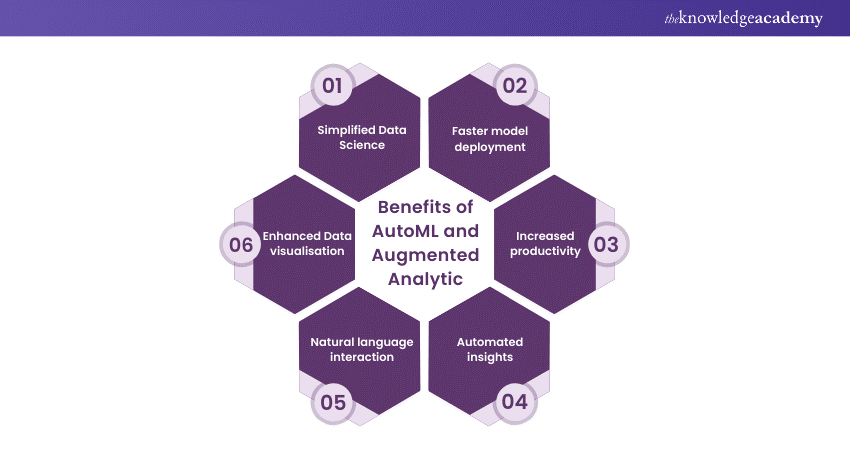
1) Simplified Data Science: AutoML democratises Data Science by reducing the expertise required to build machine learning models.
2) Faster model deployment: It accelerates model development, allowing organisations to deploy predictive models quickly.
3) Increased productivity: Data scientists can focus on higher-level tasks while routine processes are automated.
4) Automated insights: Augmented analytics tools automatically identify patterns and trends in data, highlighting crucial insights.
5) Natural language interaction: Users can ask questions in plain language, and the system generates responses, making data analysis more accessible.
6) Enhanced Data visualisation: Augmented analytics platforms offer advanced data visualisation capabilities for better understanding.
AutoML and Augmented Analytics is one of the most transformative trends in Data Science. It redefines Data Science and analytics by making complex processes more accessible and efficient. These trends empower organisations to leverage data-driven insights without requiring extensive technical expertise. As they continue to evolve, AutoML and Augmented Analytics will likely become integral components of the modern data-driven business strategy.

Natural Language Processing (NLP)
NLP is a domain of Artificial Intelligence that primarily focuses on the interaction between human language and computers. It enables machines to understand, interpret, and generate human language in a valuable way. Let’s explore how it can impact modern businesses:
1) Improved customer service: NLP-powered chatbots and virtual assistants provide 24/7 customer support, enhancing user experiences and reducing operational costs.
2) Data insights: Sentiment analysis and content summarisation tools help organisations extract valuable insights from vast amounts of textual data.
3) Chatbots: NLP is driving the development of conversational AI, making chatbots and virtual assistants more conversational, natural, and effective in understanding and responding to user queries.
4) Sentiment analysis: NLP models can analyse the sentiment expressed in text, helping businesses gauge customer satisfaction, public opinion, and market trends.
5) Content summarisation: NLP enables the automatic summarisation of long documents or articles, making information more digestible and accessible.
6) Language accessibility: NLP-driven language translation tools break down language barriers, opening up new markets and opportunities for businesses.
Natural Language Processing is one of the most important trends in Data Science that revolutionise the way humans interact with technology. Its ability to comprehend, interpret, and generate human language is making communication with machines more natural and accessible than ever before. As NLP continues to advance, it will play a key role in influencing the future of human-machine interaction and data-driven decision-making.
Become an expert in Data Science with our Advanced Data Science Certification – Sign up now!
Quantum Computing in Data Science
Quantum computing is a type of computation that leverages quantum mechanics principles to perform calculations that are currently beyond the reach of today's regular computers. Let's explore some of its benefits:
1) Improves performance: Quantum computers have the potential to perform processes and computations that are exponentially faster than classical computers. This includes tasks like factorisation and optimisation, which are critical in data analysis.
2) Reduce processing time: Quantum computing can process vast datasets more efficiently, reducing the time required for complex data analysis and pattern recognition.
3) Increase security: The advent of quantum computing also poses challenges for classical cryptography, but it also offers the potential for quantum-safe cryptography techniques.
4) New possibilities: It opens up new avenues for solving complex problems in fields like drug discovery, climate modelling, and supply chain optimisation.
Quantum Computing in Data Science is a trend with immense potential to transform the field. As this technology matures and becomes more accessible, it will unlock new horizons in data analysis, problem-solving, and data security. Organisations that embrace quantum computing in their Data Science endeavours will be well-positioned to lead in this quantum-powered future.
Ignite your analytical journey with our Python Data Science Training – Sign up today!
Data privacy and security
Data privacy and security encompass a set of practices, policies, and technologies designed to protect sensitive data from unauthorised access, disclosure, alteration, or destruction. Let’s explore
1) Advanced encryption: Implementing robust encryption techniques to protect data both in transit and at rest.
2) Access controls: Restricting access to sensitive data to authorised personnel and implementing multi-factor authentication.
3) Data minimisation: Collecting and storing only the data that is essential for the intended purpose, reducing the risk associated with unnecessary data.
4) Customer trust: Robust data security measures build trust with customers, which is essential for maintaining a loyal customer base.
5) Regulatory compliance: Ensuring data privacy and security is essential for compliance with data protection laws, avoiding costly fines and legal repercussions.
6) Brand reputation: Data breaches can severely damage a company's reputation, leading to loss of customers and revenue.
Data privacy and security are foundational to the trust and integrity of Data Science. As data continues to grow in importance and volume, organisations must prioritise robust data security measures to protect sensitive information and comply with the ever-evolving regulatory landscape. Failure to do so may have devastating consequences for businesses, making data privacy and security an important trend in the field of Data Science.
Multi-modal Data Integration
Multi-modal Data Integration is the process of combining and analysing data from various sources, including structured and unstructured data, to create a unified, holistic view of information. Let’s explore its key features:
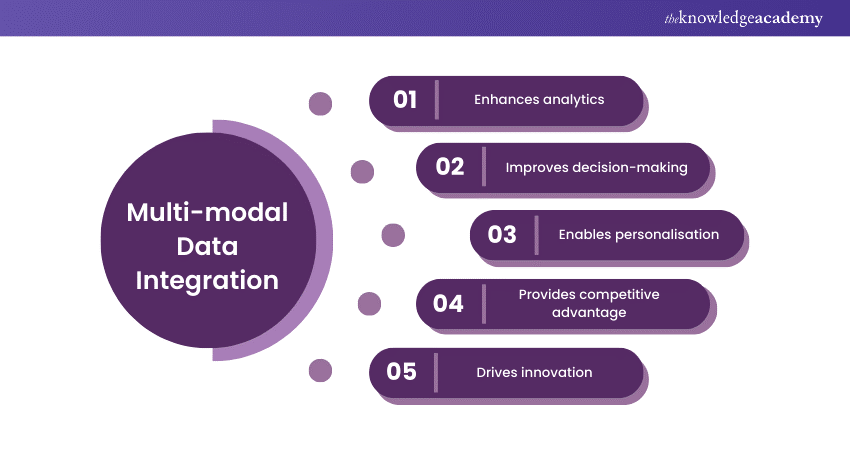
1) Enhances analytics: Multi-modal integration combines data from sources such as text, images, audio, video, and more. Combining different data types results in richer insights. For example, text analysis combined with image recognition can provide more comprehensive insights in fields like social media analytics.
2) Improves decision-making: Multi-modal integration enhances decision-making by providing a more complete and nuanced understanding of complex situations, enabling better-informed choices.
3) Enables personalisation: It enables organisations to offer personalised experiences by integrating and analysing various data types related to user behaviour, preferences, and feedback.
4) Provides competitive advantage: The ability to integrate and leverage diverse data sources gives businesses a competitive edge by uncovering hidden opportunities and risks.
5) Drives innovation: Multi-modal integration fuels innovation, especially in fields like healthcare, autonomous vehicles, and e-commerce, where a comprehensive understanding of data is essential.
Multi-modal Data Integration is transforming Data Science by enabling a more holistic understanding of complex data landscapes. As technology continues to evolve, organisations that harness this trend effectively will gain a competitive advantage by making data-driven decisions with greater accuracy and significance.
Conclusion
We hope you read and understand the Top 8 Data Science Trends. From AI-powered analytics to quantum computing and ethical considerations, these trends are reshaping industries, driving innovation, and emphasising the need for responsible data handling and security. By staying informed and adaptable, you can succeed in this dynamic field.
Revolutionise your career with our Data Science Training – Sign up today!
Frequently Asked Questions
Upcoming Data, Analytics & AI Resources Batches & Dates
Date
 Python Data Science Course
Python Data Science Course
Mon 16th Dec 2024
Mon 6th Jan 2025
Mon 17th Mar 2025
Mon 26th May 2025
Mon 14th Jul 2025
Mon 22nd Sep 2025
Mon 24th Nov 2025
Mon 8th Dec 2025







 Top Rated Course
Top Rated Course


 If you wish to make any changes to your course, please
If you wish to make any changes to your course, please


